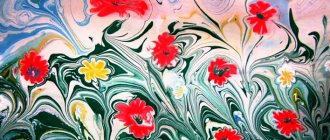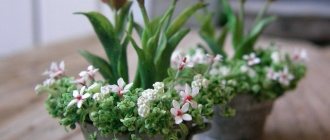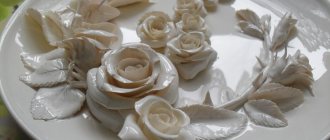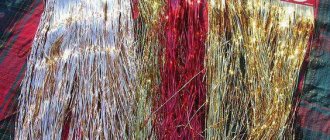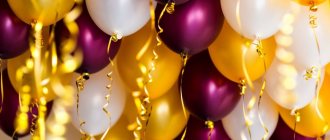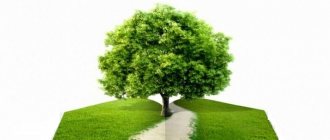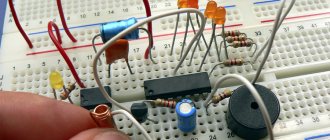Surely the following 8 DIY paint recipes will be appreciated by both children and parents!
Natural “watercolor” paints for children of all ages!
You have the opportunity to prepare paints with your child from natural ingredients that are not only harmless, but also to some extent useful if the child eats them!
What you will need:
- Yellow paint – turmeric, saffron.
- Orange – carrot juice.
- Red, pink, raspberry - beet juice, tomato juice, berry juice (viburnum, raspberry, strawberry, cranberry).
- Green – juice of spinach, parsley, dill, celery greens.
- Blue, purple, lilac - juice of red cabbage, currants, blueberries, blackberries, mulberries.
- Brown - coffee, tea, cinnamon, cocoa, chicory, decoction of onion peel or pomegranate peel.
How to cook:
- Wash the berries or vegetables and squeeze out the juice.
- If you are preparing paints from dry spices, coffee or chicory, dilute a tablespoon of powder with a small amount of water.
- The easiest way to make green dye is from pre-chopped and then frozen greens. Remove the bag or container of puree from the freezer, defrost it without opening it, and squeeze it through a cloth or sieve.
Tips for use:
- Natural dyes can be used as natural dyes in our other recipes.
- Keep in mind that natural paints cannot be stored for more than two hours at room temperature or more than a day in the refrigerator. But they can be successfully frozen in airtight containers. If you have prepared a large portion of paints, do so.
- If you want to keep your child busy with drawing right now, and you don’t have time to squeeze juice out of vegetables and berries, do it differently. Cut the washed vegetables and greens into small pieces (of course, everything should be very fresh and juicy), put the berries in separate sockets, and then offer the child a sheet of white paper and ask them to depict something using pieces and whole berries. We are sure that the child will simply be delighted!
- If you want to make unusual paints for your child, namely ice ones, then after class pour the remaining ice molds into the cells (it’s better to take ones with square or rectangular cells), insert an ice cream stick or a cotton swab into each, and send form in the freezer. Once frozen, you'll have a great ice cube painting set, just take the mold out of the freezer, wait a couple of minutes, and you're ready to paint!
What are Holi coloring agents?
“Holi” is presented in a wide variety of colors, which allows everyone to realize their colorful fantasies.
The composition is available in powder form in bags or jars. Initially, its colors were more scarce (it was produced in black, yellow and blue), but now the situation is completely different.
You can purchase the compositions online, on services and in stores that specialize in the sale of Indian paints and varnishes, materials for tattoos, body art and similar products.
But, if necessary, paint can also be purchased during the festival, which is celebrated in many countries around the world.
The early remedy was made from dried ground plants with the addition of phalaenopsis.
In the modern version, corn flour is used, colored with natural additives due to the coloring agent being considered harmless to human health.
Certain types of dye are endowed with healing properties, since they contain plants used in medicine.
High-quality materials made from natural ingredients are quite expensive due to the high costs during their production.
The most popular brand is HoliLike.
Bathroom paints
Is your child reluctant to go swimming? Then you just need to get him interested in some great creativity - painting on the bathtub and tiles!
Don't worry, no traces of creativity will remain in the bathroom - these paints are easily washed off surfaces. And the child himself will not receive colored “tattoos” on his skin after bathing.
The child's age is 2-5 years.
What you will need:
- 2 parts* baby clear shampoo.
- 1 part cornstarch.
- 1 part water.
- Food colorings.
*That is, if you measure in a glass, then take 2 glasses of shampoo + 1 glass of starch + 1 glass of water.
How to cook:
- In a metal or enamel bowl, mix water with starch (it is advisable to use warm water), then add shampoo and mix well, but do not beat! There should be no foam.
- Place the pan over moderate heat and cook until boiling, stirring constantly.
- Once boiling, remove from heat. The mixture should look like thick jelly. Let cool until warm.
- Divide the mixture into bowls or jars - their number will be equal to the number of your “paints”. For small children, I recommend making only 3-4 basic colors; for older children, you can play with mixing colors and shades.
- Add 1-2 drops of different food colors to each portion of the base, no more. I don’t recommend making a very rich color, because it will be more difficult to wash off the child’s skin. Stir each portion well (use different spoons or wooden spatulas - for example, ice cream legs).
- Transfer the resulting paints into pre-prepared jars with well-closing lids (not glass, because you will use the paints in the bath!). Jars of old finger paints, creams, small food containers, etc. will do.
That's it, the colors are ready - it's time to swim!
Tips for use:
- Never leave your child alone in the bath - this is an important safety issue!
- If the child is small, make sure that he does not eat your paints.
- It is advisable to have an oblong tray under the paints so that the paints do not fall into the water. You can use bathtub holders for soap and washcloths.
- The child can draw with his fingers or a piece of sponge.
- First, show your child how to use paints and what can be painted on the bathtub, tiles, or even on his tummy.
- At the end of the water procedure, these drawings will need to be washed off from the surfaces. To keep your child from getting upset, buy him a water pistol - and he will happily say goodbye to his art on his own. Don't forget to praise him for his accuracy!
Use of dyes
Most often, colored powder is simply sprinkled on oneself, everyone and everything around during the holiday.
Due to the fact that different shades are used and everything is mixed, all those present look uniform, bright and rich.
But this is not the only use of Holi.
It is also used:
- During photo sessions.
- In body art.
- Various parties and celebrations.
- Events that are entertaining in nature (with a large number of people).
- Concerts.
- In theatrical productions.
DIY stained glass paints
These paints can be used to paint on thick cardboard, glass, wooden surfaces, mirrors, tiles, and porcelain plates.
The designs are durable in damp environments.
Children's age is 5-8 years.
What you will need:
- PVA glue.
- Dyes.
How to cook:
- Pour 2-3 tablespoons of glue into small jars with tight-fitting lids and a wide neck.
- Add coloring to each portion. Stir until the color is uniform with wooden sticks. The paints are ready.
Tips for use:
- These paints can be used to paint directly on the selected surface.
- Or you can apply the drawing to an office file or glass (necessarily in a frame and under adult supervision!) - and let it dry for several hours. Then carefully remove the drawing from the base and glue it to any smooth surface - a corner of a mirror or window, tile, plate, etc. These drawings do not have to be large.
How to prepare chalk paint and paint furniture with it: 5 recipes at home
Every modern designer knows what chalk paint is. Decorating furniture and interior items in the shabby chic or Provence style is especially popular. Using this material you can also simply update any piece of decor or furniture.
Chalk paint is also called chalk paint (perhaps because the finished surface has a pleasant dullness, similar to chalk. Why is this material so popular and everyone wants to know the recipe for homemade chalk paint?
Depending on the components added, the surface can be either smooth or textured. And this quality can be varied by decorating different surfaces. Also, using a chalk composition, you can get a slate surface on which you can draw with chalk.
Volumetric salt paints for painting
These paints allow you to create voluminous, “plump” paintings; children really like them.
The child's age is 2-7 years.
What you will need:
- 1 part flour.
- 1 part salt.
- Required amount of water for kneading.
- Food colorings.
How to cook:
- Mix flour with salt.
- Add water in small portions and stir until smooth.
- As a result, the mass should resemble pancake batter - flow from the spoon in large drops.
- Divide the mass into different containers, add dyes to each part.
Corn starch
First, mix the starch and paint and only then, if necessary, add the required amount of water. To obtain the required consistency. To densely paint the surface, it is necessary to apply at least two layers.
The surface will be a little rough. It will need to be sanded. But in terms of quality, in general, paint with corn starch is in no way inferior to industrial paint.
Dyeing technology
Chalkboard paint is very easy to use. Anyone can paint a wall or make a cute note board with their own hands.
A hand-made slate board is not only a stylish, but also a functional attribute in the interior
The painting procedure is as follows:
- The surface to be painted should be cleaned of old coatings. If necessary, it is leveled with putty or sanded, and then washed to remove dust and dried.
- To ensure that the paint lies evenly, the surface underneath is primed and dried. Ideally, you should use a special primer for slate paints.
- To create a neat slate rectangle on the wall or refrigerator door, cover the surface around the perimeter with masking tape.
- The emulsion is mixed well and applied in several layers. Each layer must be completely dry before the next one is applied. Painting should be done in a ventilated area with an air temperature of +10°C and humidity up to 85%.
- 24 hours after applying the last layer, calcium carbonate chalk is rubbed into the dried surface. The excess is wiped off with a soft cloth.
- It remains to wait another 48 hours until the emulsion is completely cured, and the board or wall can be used for its intended purpose.
You can wash the slate surface with soap or other household chemicals only a month after painting.
Varieties of CM
Chalk paint was first used in 1990 by a British designer. It went on sale under the Chalk Paint brand. The recipe remained secret. Therefore, specimens have been developed that contain different constituent elements. They are all water based and differ in additives. The name of chalk paint depends on them.
- Natural and synthetic resins are found in resin dyes.
- Silicates are mineral constituents.
- If casein is added, then it is milk paint.
- Flax oil is contained in the oil composition.
Painting creates a smooth or embossed layer. On the first one you can draw. The core of textured or slate CM is acrylic, silicone, latex emulsion.
In order for the slate coating to have the properties of a magnet, metal particles are introduced into the latex composition. Magnetic dye interacts with any material.
The chalkboard effect is created by emulsions of dark shades. In this case, chalk patterns are visible on the surface. Manufacturers have developed colorless formulations. The pigment of the desired color is introduced and converted into a colored slate board.
Mother-of-pearl composition is used to decorate walls and interior items. The ceiling is painted white. You can use the ready-made whitewash composition or prepare it yourself.
The base that comes into contact with fire is coated with fire-resistant paint. To secure the decor, the product is fired with fire. In both situations, chalk compounds are used that can withstand prolonged temperature exposure. They belong to heat-resistant materials. This group includes stained glass paints for painting glass and ceramics.
Useful tips
Painting and subsequent drying of the surface must take place in a room with a certain microclimate, the air temperature must be at least 10°C, and the humidity must not exceed 85%. After 24 hours, the surface with a slate effect must be treated with calcium carbonate chalk, rubbing it in with soft circular movements.
The painted surface can be used no earlier than after two days. It is necessary to wait until the layer is completely cured. When preparing the composition for painting a surface, you need to correctly calculate the consumption. Textured paint has a higher composition consumption compared to slate paint. To paint 1 m² you need at least 600 g.
Watch the following video for a master class on the recipe for the smoothest chalk paint with your own hands.
